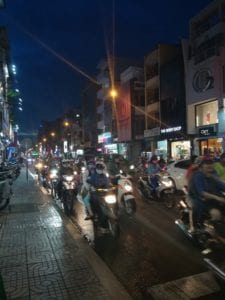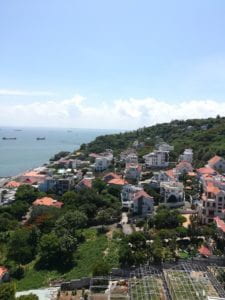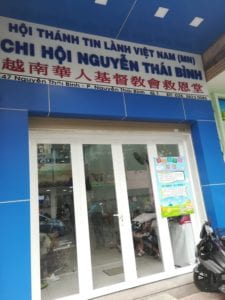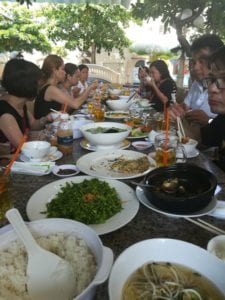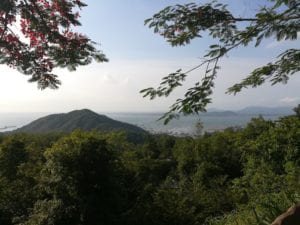HO CHI MINH CITY
Anmei
Let me tell you about Ho Chi Minh City. It starts in Jakarta, where I got a text from my friend Yuling, who had previously connected us with her former Chinese teacher in Ho Chi Minh City. She informed us that her Chinese teacher, Ms. Huang, wouldn’t be able to meet us on the weekend that we had originally planned because she was going on vacation–but that Ms. Huang thought, actually, it was perfectly fine if we simply joined her and her church friends on that vacation. They were going to Vung Tau, a sunny city on the coast of Vietnam, and suggested that we interview them during the weekend trip. Nicole and I sat down at her dining room table in Jakarta and debated the offer. It presented an abrupt change in our itinerary, and Ms. Huang and her friends were technically complete strangers. But we knew that they were all Chinese-Vietnamese, so it could be immensely rewarding for our project to spend a weekend with them. Before our Travel Fellowship began, we spoke with Tim, a Yale-NUS alumni who had completed his own Fellowship. From his experiences gathering anthropological evidence in China, Tim advised us to go beyond the normal, scripted interview and consider tagging along with whomever we planned to interview as they went through their ordinary routines. Details about an individual’s way of life can’t always be revealed through a brief exchange of spoken words; it’s often through time that “interviewees” open up and through continuous observation that “interviewers” find below-the-iceberg cultural information. Spending a weekend with Ms. Huang and her friends would give us the chance to create bonds, friendships even, that might lead to deeper insights about their Chinese-Vietnamese experiences.
In the end, Nicole and I decided to go to Vung Tau. It was weeks of back and forth between Ms. Huang and us to set the logistics straight, and I was convinced I had everything perfectly arranged…until our last day in Manila, when I realized that I had somehow mixed up the dates. We were set to arrive in Vietnam a day later than I thought, which meant that we couldn’t make it on time to join Ms. Huang and her friends on their departure to Vung Tau. While I was dying of embarrassment and rapidly trying to amend our itinerary again, Ms. Huang was (luckily) unfazed and offered to stay back in Ho Chi Minh City, wait until we arrived, and accompany us to Vung Tau a bit later than planned. What a saint.
So after standing in the Manila airport for 2 hours straight because no seats were available, barely surviving a 6 hour layover in Singapore, and catching virtually 20 minutes of sleep on the plane to Vietnam, Nicole and I arrived in Ho Chi Minh City. It wasn’t my first time in the city; I had visited last December with friends for a quick getaway trip. Later, I would decide that a city feels different each time you visit–depending on the goals you have in mind, the people (or lack of people) you’re with, and the prior cultural knowledge you possess. This time around, I felt relatively confident in navigating the city (and the culture) and, when I revisited museums or historical sites, I realized that I could approach them with a more cohesive picture of Ho Chi Minh City in mind. Still, it was also refreshing to see a different city in Vietnam. Vung Tau is a 3 hour drive from Ho Chi Minh City, a popular vacation destination for locals because of its insanely clear ocean waters and lack of urban smog. Nicole and I stayed with Ms. Huang and her friends atop a lush green mountain–needless to say, the views were unforgettable. In Vung Tau, we essentially followed the group around for an entire weekend as they laughed, ate, conducted church gatherings, and relaxed near the beach. Ms. Huang is a third generation Chinese immigrant, as are most of her friends. They almost always spoke in Guangdong dialect amongst themselves and conducted their church services in dialect too (which we found out later when Ms. Huang invited us to attend their Sunday church gathering back in Ho Chi Minh City). I was impressed with the amount of what I associate with “Chineseness” they seemed to possess as third generation Chinese immigrants. This is because some of the other third generation Chinese individuals we spoke to on our journey, like our friend Esther in Singapore, conveyed that they possessed weak Chinese language skills and identified more strongly with the local culture or ethnicity. But Ms. Huang and her friends confidently declared themselves as Huaren. Comparing the qualities of all the Chinese immigrants we had interviewed, it was clear to me that the experience of being ethnically Chinese is not fixed or regular or predictable–it varies among the same generation, among citizens living in the same area, and even among individuals in the same family.
This brings to me to an idea that one of our interviewees in Vietnam brought up: that identity, even individual identity, is collective. Identity, as how I perceive it in the context of our project, is how one perceives oneself. The interviewee stated that “if every day we connect ourselves to other people, how can who we are inside not be connected to who they are inside too?” What he said really made me think. In some aspects, the way we perceive ourselves can’t help being influenced by how others perceive us. Unless an individual exists in social isolation, how can his identity really be one, singular thing? Ideas, habits, preferences, etc. from others can so easily seep into one’s way of being through socialization. It’s difficult to separate or dissect an individual’s identity (be it personal identity, national identity, or ethnic identity because even individuals of the same nationality/ethnicity will have different experiences of what it means to be that nationality/ethnicity). Everyone sort of exists as a collective melting pot of its own, thanks to interacting in a social network of a million other identities.
I hope I’m making some sense. However, this realization was meaningful to my personal journey because, growing up, I often felt uncomfortable about having two distinct identities, Chinese and American. Now, reflecting on this, I understand that I was uncomfortable because I thought I was different–everyone around me seemed to have one identity (American)–and I didn’t want to be different. I wanted to belong, to have a sure-thing identity like everyone else. But the thing is…now it’s obvious to me that no one actually has a “sure-thing” identity. No one is purely one thing. On this Travel Fellowship, I’ve really enjoyed getting to speak with Chinese immigrants who have faced similar identity struggles as I have. Many of them are older and have made peace with who they are, and I think that the words they offer to Nicole and I are slowly helping us to make peace with who we are too (as cheesy as that may sound). On to Bangkok.
